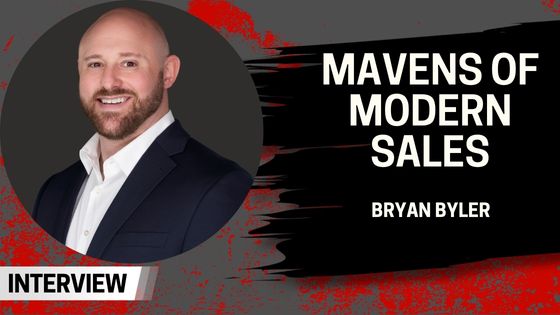
Mavens of Modern Sales – Bryan Byler

Welcome to Mavens of Modern Sales, where we take a deep dive with the sales leaders pulling sales teams in the 21st century to get their insights on leadership, strategy, industry trends, and more.
This week we talked to Bryan Byler. Chief Revenue Officer at Aptitude 8.
Let’s start with something that recently caught your attention. You were surprised to learn that marketing students hadn’t heard of tools like HubSpot or Marketo. In your view, what skills or knowledge should be considered baseline for new grads entering the sales/marketing/revenue fields today?
Absolutely. I was recently speaking to a group of graduating marketing students and was surprised to learn that many hadn’t heard of platforms like HubSpot or Marketo. It highlighted a disconnect between academic programs and the tools driving modern go-to-market strategies.
For anyone entering the sales, marketing, or revenue fields today, there are a few fundamentals I’d consider baseline:
Systems awareness. New grads don’t need to be platform experts on day one, but they should be familiar with the major players in CRM, marketing automation, and sales enablement. HubSpot, Salesforce, Marketo, and others form the operational backbone of how high-performing teams execute.
Data literacy. A solid grasp of core metrics—conversion rates, customer acquisition cost, pipeline velocity—allows new hires to contribute faster and think more critically. Understanding how to interpret data and tie it to business outcomes is essential.
AI readiness. Generative AI is reshaping everything from campaign execution to sales enablement and forecasting. Being comfortable with AI tools and understanding how to use them thoughtfully is no longer optional.
Lifecycle thinking. Sales, marketing, and customer success can’t operate in silos. I look for people who understand how these functions work together to drive revenue across the full customer journey.
The pace of change in this space is rapid. Formal education may lag behind, but for those who are self-motivated and curious, it’s an incredible time to build a competitive edge early in your career.
You’ve mentioned that follow-up emails can make up for a weak call if done right. What does that actually look like in practice? Do you coach reps to include elements like ROI, cost of inaction, or specific use cases to make the message stick?
Great question—and one that gets to the heart of modern sales execution.
The reality is, not every call is a home run. Sometimes the prospect is distracted, the timing is off, or the rep just doesn’t land the value clearly in the moment. That’s where a well-crafted follow-up can completely change the trajectory of a deal.
In practice, I coach reps to treat the follow-up not as a summary, but as a second chance to deliver value with clarity and precision. The best follow-ups do three things:
First, they reinforce relevance. This means recapping the prospect’s pain points or priorities in their language, not ours. If we’ve listened well, we should be able to reflect their goals back to them in a way that feels personalized and specific.
Second, they quantify impact. This is where we layer in ROI, cost of inaction, or benchmarks—especially if we didn’t get a chance to do that effectively on the call. We want to help the buyer build their internal business case, and numbers help anchor the conversation in outcomes, not features.
Third, they offer a clear next step. Whether it’s aligning stakeholders, reviewing a demo, or exploring implementation paths, the follow-up should always guide the deal forward.
We also emphasize tone. A great follow-up doesn’t feel canned or salesy. It feels thoughtful, confident, and consultative. When done well, it not only salvages a mediocre call—it builds trust and repositions the rep as someone worth engaging with.
A strong follow-up can be a competitive advantage. It’s often the difference between being remembered and being forgotten.
You’ve also said that sales teams don’t need more leads, they need the right ones. What criteria does your team use to define a “right-fit” lead?
That’s exactly right. In most cases, the issue isn’t volume, it’s alignment. More leads only help if they’re the right leads, and chasing the wrong ones drains both time and trust across the go-to-market team.
At our firm, we’ve worked hard to define what a “right-fit” lead looks like. For us, it starts with three core criteria:
1. Strategic fit. We’re not just looking at industry or company size. We’re evaluating whether the prospect’s business model and growth goals align with what we’re purpose-built to solve. For example, if a company is trying to unify its go-to-market motion on HubSpot and needs a long-term partner, that’s a strong fit. If they’re just shopping for a one-off implementation with no real investment in adoption or scale, we’ll likely pass.
2. Operational readiness. We’ve learned that timing and maturity matter. A right-fit lead isn’t just interested—they have the internal structure, executive support, and urgency to act. That means they’re ready to make decisions, allocate resources, and embrace change. If those pieces aren’t in place, the deal might close, but the relationship won’t thrive.
3. Cultural alignment. This is often overlooked, but it’s critical. We partner best with teams who are collaborative, forward-thinking, and open to guidance. If the tone of early conversations is transactional or combative, that’s a red flag—because success in a services engagement requires trust and shared commitment.
We’ve operationalized these signals in our qualification process, so we’re aligning early and clearly. When we focus on right-fit leads, win rates go up, churn goes down, and our team can spend more time doing transformative work instead of just delivering projects.
When it comes to leadership, you’ve talked about the importance of involving your team in problem-solving. What advice would you give to leaders who struggle with letting go of control and bringing their team into the decision-making process?
Letting go of control is one of the hardest transitions for any leader—especially for those who built their careers by being the person with the answers. But the truth is, as your scope grows, your job shifts from solving problems to building a team that can solve them better than you ever could.
For leaders who struggle with this, my first piece of advice is to reframe what leadership actually means. It’s not about having all the answers. It’s about creating the conditions where the best answers can emerge from the team. That means being curious, not directive. Asking the right questions. Creating space for healthy debate.
Second, start small. You don’t need to delegate strategic decisions right away. Begin by inviting your team into decisions where the stakes are lower but the learning opportunity is high. Frame the problem, outline the context, and then ask, “How would you approach this?” Over time, that muscle builds—on both sides.
Third, get comfortable with imperfection. Sometimes your team’s approach won’t match how you would’ve done it. That’s okay. If the outcome is strong and the decision-making was sound, you’re still winning. Growth comes from ownership, and ownership requires room to move.
Lastly, model transparency. When you involve your team in real problem-solving, it builds trust and creates buy-in. People support what they help build. And in fast-moving environments—especially in the revenue world—that kind of alignment is invaluable.
Letting go of control doesn’t mean stepping back. It means stepping up in a different way—one that scales your leadership through others.
While building your 2025 revenue model, you mentioned using 14 different data points. What are a few underrated metrics you think more revenue leaders should be tracking?
When we built our 2025 revenue model, we grounded it in data—14 core inputs that gave us a clear, defensible view of what’s possible and where the constraints are. Too many revenue plans are built backwards from a board target or CRO “vibes.” I’m just not interested in that. This model had to be something the team could trust and execute against.
Some of the most impactful data points we used included:
Demand generation forecast. Not just top-of-funnel lead volume, but expected contribution broken down by channel and campaign type, based on historical performance and conversion rates.
Pre-sales team capacity. Especially in a consulting business, you can’t scale revenue without understanding delivery readiness. We modeled out how many qualified discovery calls our solutions consultants could support without compromising depth or velocity.
Gross and qualified close rates. We separate every opportunity into a “gross” rate (how many enter the pipeline) and a “qualified” rate (how many we believe fit our ICP). This gives us a much clearer picture of true performance, especially when we’re layering in new segments or go-to-market motions.
Historical ramp and attainment. We analyzed how long it takes new reps to ramp, what quota attainment looks like over time, and how seasonality has impacted revenue contribution in prior years. It helped us be realistic about when new hires start making a real impact.
Sales cycle by deal type. Not all revenue behaves the same. Enterprise, mid-market, and expansion deals move at different speeds. Modeling each path individually gave us a more accurate forecast.
Service margin and delivery velocity. We can’t just model bookings—we need to understand how quickly those bookings turn into revenue, and how profitably. So I consider things like average delivery timelines and cost-to-serve for each type of engagement.
If you’re serious about forecasting, you can’t afford to rely on instinct or oversimplified spreadsheets. A modern revenue plan should be a living model—grounded in real inputs, adaptable to change, and transparent enough that every leader can see how their team contributes to the outcome.
In your experience, what’s one thing sales teams tend to waste too much time or energy on—and how would you recommend redirecting that effort?
One of the biggest drains on sales teams is spending too much time trying to create urgency instead of uncovering it naturally.
Reps often default to pushing timelines, manufacturing pressure, or relying on artificial deadlines. It’s exhausting, and frankly, it rarely works. If there’s no urgency behind the problem, there’s no momentum in the deal.
Instead, I coach our team to spend that energy identifying the cost of inaction. What happens if the prospect does nothing? What are they losing—revenue, efficiency, market position—by staying in the status quo? When you uncover the real business impact of waiting, urgency becomes organic. It comes from them, not us.
This also shifts the rep’s posture from trying to close to trying to solve. It builds trust, sharpens the value story, and accelerates deals with a stronger foundation.
So much time is wasted on trying to push a deal that isn’t ready, when that same time could be spent qualifying better, personalizing smarter, or investing in accounts that are ready to move. Urgency is powerful—but only when it’s real.
With so many tools available, how do you personally evaluate what’s worth adding to your team’s tech stack versus what might just be a distraction?
It’s a noisy market out there. Every week, there’s a new tool promising to “revolutionize” some piece of the revenue engine. But as a CRO, my job isn’t to chase innovation—it’s to enable performance. That means being ruthless about what earns a place in our stack.
I evaluate every tool through three filters:
1. Does it increase clarity? If it doesn’t give my team better visibility into the buyer journey, pipeline health, or performance metrics, it’s a no. Tools like HubSpot have set a high bar here. It’s our source of truth, not just for CRM, but for marketing attribution, deal progression, and engagement. If a new tool can’t integrate cleanly with HubSpot and enhance what we already see there, it’s not worth the overhead.
2. Does it improve the buyer experience? We’ve made intentional investments in things like digital sales rooms because they simplify and elevate how prospects engage with us. When we can deliver everything—case studies, pricing, timelines, ROI calculators—in one centralized, branded space, it builds trust and removes friction. That’s a win for both sides.
3. Does it drive efficiency at scale? I’m not interested in tools that make one person 10% better. I’m looking for platforms that can shift the curve for the entire team. Whether it’s automation, AI, or enablement, the question is always: does this help us do more of the right work, faster?
There’s no shortage of tech. The key is knowing what truly adds value versus what just adds complexity. The best tools fade into the background—they empower your team without becoming another thing they have to manage.
And finally, we always like to end with this: What’s a career focused book, tool, podcast, or resource that’s had a big impact on you and why?
There are a few that have really shaped how I lead and think about building high-performance teams.
For books, The Score Takes Care of Itself by Bill Walsh stands out. It’s not a traditional sales or business book, but it’s one of the best playbooks for leadership I’ve ever read. His philosophy around setting a standard of excellence—not just chasing outcomes—has deeply influenced how I think about culture, accountability, and long-term success. When you build the right habits and mindset, the results follow. That message has stayed with me.
As for tools, it has to be HubSpot. It’s the backbone of how we operate. From CRM and marketing automation to reporting and customer success alignment, it’s the one platform I’ve seen consistently empower go-to-market teams to work smarter and faster. And with the acceleration of AI inside the platform, it’s only getting more powerful.
For podcasts, I’ve been drawn to shows that offer honest, unfiltered conversations about leadership—The Diary of a CEO is a standout. Episodes with guests like Whitney Wolfe Herd have been especially impactful. I also think Hello Monday with Jessi Hempel brings a thoughtful lens to career growth, company culture, and the changing nature of work. I appreciate voices that challenge conventional thinking and aren’t afraid to get into the messy, real parts of leadership.
I try to keep a healthy mix of tactical, strategic, and human in my learning diet. The best leaders I know are always learning, always listening, and always evolving.
Bryan Byler is the Chief Revenue Officer of Aptitude 8, an Elite Solutions Partner focused on technical implementation, integration, and optimization of HubSpot. In addition to being a former HubSpotter, Bryan has more than 15 years experience in scaling professional services organizations to new heights. When he is not piloting the rocketship, Byler enjoys rock climbing and building LEGO sets with his sons.
































